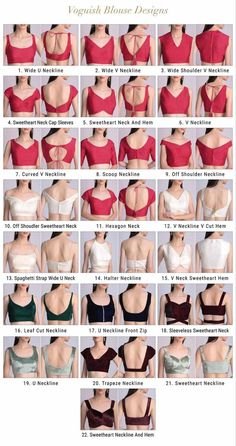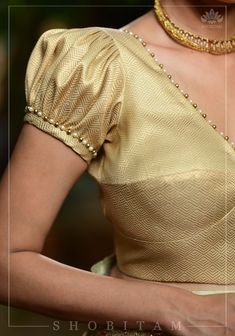Blouse With Lining
Blouses are essential garments worn primarily by women, often paired with sarees, lehengas, skirts, or trousers. They come in various styles, designs, and fabrics, catering to both casual and formal occasions. Blouses typically cover the upper body and can vary in sleeve length, neckline style, and overall fit. They are versatile pieces that can be customized with embellishments, embroidery, or unique cuts to enhance their aesthetic appeal.

Importance of Lining in Blouses: A lining in a blouse serves several important functions that contribute to both the comfort and appearance of the garment:
- Opacity: Lining fabric provides opacity to the blouse, ensuring that it is not see-through, especially when using sheer or lightweight fabrics for the outer layer.
- Comfort: Lining adds a layer of comfort against the skin, preventing direct contact with potentially scratchy or uncomfortable outer fabrics.
- Structure and Shape: Lining helps to maintain the structure and shape of the blouse, ensuring it drapes well and fits smoothly over the body.
- Durability: A lining can increase the durability of the blouse by protecting delicate outer fabrics from wear and tear, reducing friction, and preventing stretching.
- Enhanced Finish: Lining contributes to a professional and polished finish inside the blouse, hiding seam allowances and providing a neat appearance.
Types of Lining Fabrics: Choosing the right lining fabric depends on the outer fabric of the blouse and the desired effect. Common types of lining fabrics include:
- Cotton: Cotton lining is breathable, comfortable, and suitable for blouses made from natural fibers like cotton or linen.
- Silk: Silk lining adds a luxurious feel to the blouse and is often used for silk or satin blouses, providing a smooth finish and enhancing drape.
- Polyester: Polyester lining is durable, easy to care for, and suitable for a wide range of blouse fabrics. It can also provide additional structure.
- Rayon: Rayon lining is lightweight and breathable, making it suitable for blouses made from lightweight fabrics like chiffon or georgette.
- Bemberg (Cupro): Bemberg lining, also known as cupro lining, is made from regenerated cellulose fibers and offers a silky texture and excellent drape.

Steps to Sewing a Blouse with Lining:
Materials Needed:
- Outer fabric for blouse
- Lining fabric
- Pattern for blouse
- Measuring tape
- Fabric chalk or pencil
- Scissors
- Pins
- Sewing machine or needle and thread
- Iron and ironing board
Step-by-Step Guide:
- Prepare the Pattern:
- Choose a blouse pattern that includes instructions for adding a lining or select a basic blouse pattern and modify it to include lining.
- Cutting the Fabrics:
- Cut out the blouse pieces from both the outer fabric and the lining fabric, following the pattern instructions.
- Ensure that each piece (front, back, sleeves) is cut from both the outer fabric and the lining fabric.
- Assembling the Outer Blouse:
- Begin by assembling the outer blouse following the pattern instructions. Sew the shoulder seams, side seams, and any darts or pleats as required.
- Finish the edges of the outer blouse with a serger or zigzag stitch to prevent fraying, especially if the fabric is prone to fraying.
- Preparing the Lining:
- Assemble the lining pieces in the same manner as the outer blouse, sewing the shoulder seams, side seams, and finishing the edges.
- Attaching the Lining:
- With the outer blouse right side out and the lining inside out, slip the lining inside the outer blouse so that the wrong sides of the lining and outer fabric are facing each other.
- Align the neckline and armholes of the outer blouse and the lining. Pin them together along the edges.
- Sewing the Neckline and Armholes:
- Sew around the neckline and armholes, joining the outer blouse and lining together. Leave a small opening for turning right side out.
- Clip curves and trim excess seam allowance to reduce bulk. This step ensures that the neckline and armholes lie flat and smooth.
- Turning Right Side Out:
- Carefully pull the blouse through the opening so that the outer fabric and lining are now right side out.
- Use a point turner or blunt end of a pencil to gently push out the corners and edges to ensure crisp, clean lines.
- Finishing:
- Press the neckline and armholes carefully to ensure they lay flat and the seam is well defined.
- Slipstitch or topstitch the opening closed where the blouse was turned right side out.
- Hem the bottom of the blouse and sleeves if necessary, ensuring the lining is slightly shorter to prevent it from peeking out.
- Final Touches:
- Try on the blouse to check the fit and adjust any final details if needed.
- Press the entire blouse once more to ensure a professional finish and remove any wrinkles.

Conclusion: Sewing a blouse with lining requires attention to detail and precision to ensure a comfortable fit and a polished appearance. By following these steps and choosing appropriate fabrics, you can create blouses that not only look stylish but also feel comfortable and durable. Lining adds functionality to the blouse, enhancing its structure and ensuring it drapes beautifully over the body. With practice, you can master the art of sewing blouses with lining and customize them to suit your personal style and preferences.
